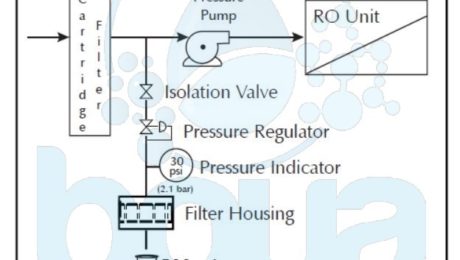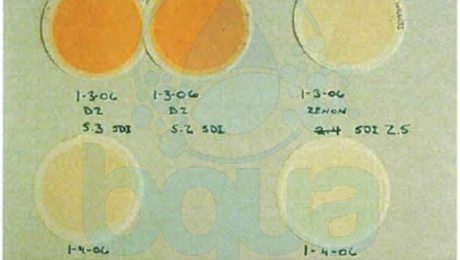What is Silt Density Index SDI Measurement
Silt Density Index SDI roughly measures the fouling potential of a Reverse Osmosis System feed water. In other words, it is supposed to tell us if a feed water is likely to foul a Reverse Osmosis System or not. For the SDI measurement, the filter used is a cellulose acetate membrane filter with pores of around 0.45 micron. The filters are generally 47mm in diameter.
Silt Density Index SDI Clean Dirty/Plugged Filter Example
These SDI membrane filters will plug with particulate matter when a sample is filtered through them. If the pressure is kept constant, the amount of flow through a filter will decrease as the pores become plugged.
Silt Density Index SDI Filter Measurement
SDI measurements may be taken on any stream. The one that the membrane manufacturers are concerned about, however, is the SDI of the feed water as it enters the elements. This is generally taken at the suction of the high pressure pump, after all of the feed water pretreatment has been accomplished.
Silt Density Index SDI Measurement Method in Reverse Osmosis
Generally, three-eighth inch (9.5 mm) tubing is used to pipe the feed water stream to the filter housing. A shutoff valve is required to isolate the filter when not in use. A pressure regulator is required to maintain the pressure at 30 (2.1) psi(bar) throughout the test. A pressure gauge is required to monitor the pressure. A filter housing is required to hold the 0.45 micron filter.
Silt Density Index SDI Measurement Method Reverse Osmosis System
A 500 ml graduated cylinder is placed under the filter to collect the filtered water (Figure 14.12). The
time required to filter 500 ml is measured at the beginning and at the end of a 15 minute period
during which the feed water is being filtered by the 0.45 micron filter.
Silt Density Index SDI Measurement Reverse Osmosis
If there were no particles in the feed water, the filter would not plug at all, so the amount of time required to pass 500 ml through the filter should be the same at the end of 15 minutes as it was in the beginning. If particulate matter plugs the pores of the filter during the 15 minute test, however it will take a longer period of time to pass 500 ml through the filter at the end of the test than it did in the beginning.
SDI is a relative comparison of the amount of time required to pass 500 ml through a 0.45 micron filter before and after a given time period. The time period for RO membranes, required by the membrane manufacturers, is 15 minutes. The actual calculation of SDI is the following:
SDI =Â 100x(1-t1/t2) / T
Where:
t1 = Time required to pass 500 ml in the beginning, in seconds.
t2 = Time required to pass 500 ml at the end, in seconds.
T = Time between the beginning of t1 and beginning of t2, in minutes.
SDI Measurement Procedure Summary
A quick summary of the procedure is given.
STEP 1:Â Â Flush the SDI apparatus without the filter disc installed in the filter housing. This is required in order to flush out any particles which have become lodged in the lines since the last measurement.
STEP 2:Â Â Install a 0.45 micron filter in the housing. Bleed out any air then tighten the housing nuts. Place the discharge line of the filter into a 500 mL graduated cylinder.
STEP 3:Â Â Open the isolation valve and simultaneously start a stopwatch to begin timing.
STEP 4:Â Â Measure the time required (t1) to pass 500 mL. The pressure to the filter MUST remain at 30 (2.1) psi(bar) the entire time.
STEP 5:Â Â Allow feed water to continue to flow at 30 (2.1) psi(bar) of pressure through the filter for a total (from the beginning of t1) of 15 minutes.
STEP 6:Â Â Right at the end of 15 minutes, again measure the amount of time required to pass 500 ml.
STEP 7:Â Â Perform the SDI calculation.
- Published in Water Treatment
What is Silt Density Index SDI Definition
The Silt Density Index (SDI) is an analytical procedure which measures the fouling potential of a sample stream, it is basically the parameter most used to determine how much pretreatment is required in designing Reverse Osmosis Systems. In reality, it is a very rough indicator of fouling potential. SDI is based upon the principal that when a filter gets plugged, less water will pass through at the same pressure. Less water passes through because of the resistance to flow caused by particles plugging the spaces in the filtering medium.
Silt Density Index SDI for Clean vs Dirty/Fouled Filter
A sample stream of the raw water is filtered through a new 0.45 micron membrane filter for fifteen minutes. The amount of time required to pass 500 ml through the filter is measured initially, (when the membrane filter is clean), and again after fifteen minutes worth of suspended material have been filtered. The reduction in flow rate (longer time to pass 500 ml at the end of the 15 minute period) is a crude measurement of the fouling potential of the stream.
SDI filter pads after testing turbidity in seawater
Most spiral wound RO membrane element manufacturers require that an RO System feed water has a fifteen minute SDI value (SDI15) of less than 5 (one manufacturer requires less than 4). An SDI15 of 5 is obtained when it takes four times longer to pass 500 ml after fifteen minutes worth of suspended solids have been deposited on the membrane than it did during the initial 500 ml. Most hollow fiber element manufacturers require that the SDI15 be less than 3.
When a membrane element supplier requires that an RO System feed water SDI15 be less than 5, this means that the feed water SDI15 must be less than 5 as it enters the Reverse Osmosis System The problem is that the particles may grow. In the case of living particles, they grow and reproduce like any organism. They add mass by accumulating nutrients from the environment. They add numbers by reproduction. Nonliving particles may grow in an Reverse Osmosis System as well. They grow by physical/chemical means called coagulation or agglomeration.
The purpose of our pretreatment equipment is to remove the relatively large particulate matter from the feed stream so it does not plug the Reverse Osmosis Systen and to limit the number of living particles entering a unit. The purpose of dispersant addition is to then keep the smaller, especially nonliving particles from agglomerating (growing larger) and remaining in the RO System.
Silt Density Index SDI and Reverse Osmosis System
Since SDI is a measurement of both living, dead, and nonliving particulate matter greater than 0.45 micron, it is a useful tool to determine the fouling potential of a feed water and how much pretreatment equipment will be required. Some general guidelines on what it will take to maintain an RO unit’s feed water SDI at less than 4 – 5 are:
| RAW WATER SDI | PRETREATMENT REQUIRED TO ACHIEVE SDI < 5 |
| Greater than 10 – 20 | Clarification, MMF, CF, +/- Dispersant (plugs in less than 5 – 10 mns) |
| 7 – 8 TO 10 – 20 | MMF (with polymer addition), CF, +/- Dispersant |
| 5 TO 7 – 8 | MMF, CF, +/- Dispersant |
| Less than 5 | CF, +/- Dispersant |
- Published in Water Treatment



